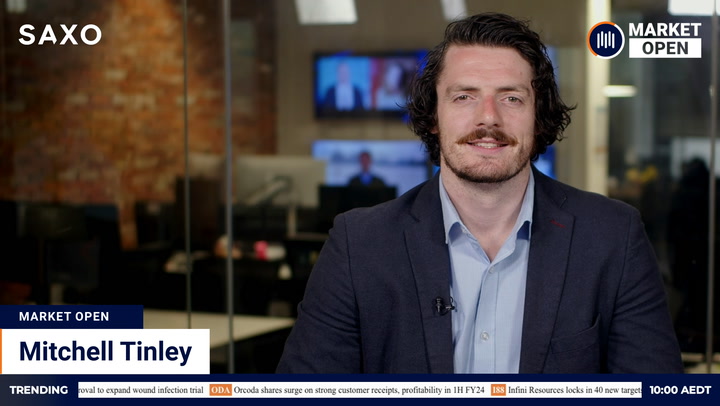Aussie shares were set to open lower after Wall Street extended its run of weekly losses as inflationary pressures continued to drag on the market.
ASX futures dropped 51 points or 0.71 per cent, signalling a soft start after Friday’s 159-point swoon on the S&P/ASX 200. The Australian benchmark fell for a third week amid concerns rate hikes to curb inflation will tip economies around the world into recession.
Commodity markets finished mixed. Oil and gold advanced. Iron ore and industrial metals fell on demand worries. The dollar traded below 71 US cents.
Wall Street
US stocks added to Thursday’s heavy losses as long-term interest rates climbed to their highest since 2018. Nine of eleven sectors declined as evidence of wages pressure overshadowed stronger-than-expected employment figures.
The S&P 500 retreated 24 points or 0.57 per cent in choppy trade. The Dow Jones Industrial Average gave up 99 points or 0.3 per cent. The Nasdaq Composite dropped 173 points or 1.4 per cent to a two-year low.
The falls sealed the indices’ longest weekly losing runs in more than a decade. The benchmarks finished lower despite starting last week with three straight advances.
The Dow has fallen for six weeks. Five-week losing runs for the S&P 500 and Nasdaq Composite are the longest since 2011 and 2012, respectively. The Nasdaq has lost a quarter of its value since November.
Rate-sensitive growth stocks were a major weight on Friday as rising treasury yields underlined expectations for a series of sharp rate increases this year. Stocks hit session lows as the ten-year US yield reached 3.13 per cent, its highest since 2018.
“Ninety-five percent of the driver of the market right now is long-term interest rates,” Jay Hatfield, chief executive of Infrastructure Capital Management, told Reuters.
April jobs figures were stronger than economists predicted. Non-farm payrolls increased by 428,000, versus expectations for an increase of 400,000.
But markets were troubled by a stubbornly-low participation rate, which is adding to inflationary pressures by forcing companies to raise wages. Participation declined to 62.2 per cent from 62.4 per cent in March and remains a full percentage point shy of pre-pandemic levels.
Hourly pay has increased by 5.5 per cent over the last 12 months, the strongest rate since the 1980s. Rising labour costs loom as another headwind for markets.
Energy was the session’s best-performing sector as a week-long rally in oil continued. Higher oil prices are a win for energy investors, but a major cost for many industries.
Australian outlook
The S&P/ASX 200 was poised to open at its weakest level since mid-March after bulk metals and US stocks declined on Friday.
The Australian benchmark has outperformed Wall Street this year, trading near record levels as recently as April 20. The market has been supported by strong commodity prices and a more benign outlook for inflation and rates.
However, there were signs last week Chinese lockdowns were starting to weigh on bulk metals. Iron ore slumped 4.6 per cent on Friday. Copper fell to a four-month low earlier in the week.
“The lockdown in Shanghai has lasted more than a month, and we believe that it will continue for another month (throughout May). Beijing is now starting mass Covid-19 testing and is therefore in partial lockdown,” ING’s chief economist for Greater China, Iris Pang, said.
Chinese authorities have talked up support for the economy, but concrete measures so far have been modest. ING announced it was cutting its full-year China GDP forecast from 4.6 per cent year-on-year to 3.6 per cent.
So-called “commodity currencies” struggled last week. The Australian dollar opened near a three-month low this morning, down 0.13 per cent at 70.69 US cents.
The US materials sector was Friday’s weakest performer, falling 1.36 per cent. Big Tech also came under pressure. The consumer discretionary, communication services and technology sectors lost between 0.8 and 1.3 per cent.
Energy was the session’s standout, rising 2.91 per cent. Utilities was the only other gainer, adding 0.8 per cent.
Back home, the impact of the rising cost of living on consumer and business confidence will come under the spotlight this week. Monthly business confidence and weekly consumer confidence surveys are due on Tuesday. Monthly consumer sentiment data follow on Wednesday.
Overseas, Wednesday night’s US inflation report is the week’s big-ticket event. Economists expect headline consumer inflation to moderate from a 40-year high. Anything less than a substantial drop will maintain pressure on the Federal Reserve to raise rates.
Back home, the mini AGM season continues this week with meetings for shareholders in Atlas Arteria (Tuesday); GPT Group, Grange Resources, Unibail-Rodamco-Westfield (Wednesday); and Tabcorp, Ampol, Sigma Health and Waypoint REIT (Thursday).
IPOs: the resurgence in market turbulence has put a brake on the recent improvement in listings. Just two companies were scheduled to debut this week, down from seven last week. Southern Cross Gold was pencilled in for Wednesday. Bellavista Resources follows on Thursday.
The biggest float of the year will have done little for sentiment. Disruptive assay analysis firm Chrysos lost a third of its market value on Friday, diving 36.15 per cent.
Commodities
Oil ended a strong week with another up-leg as the European Union edged towards a total ban on Russian energy. Brent crude settled US$1.49 or 1.3 per cent higher on Friday at US$112.39 a barrel. For the week, the international benchmark advanced 4.9 per cent.
“Crude prices just want to head higher as energy traders completely fixate over the looming European sanctions on Russian oil. No one wants to be on the wrong side of a major crude supply disruption headline, so whatever oil price dips that happen will be short-lived,” Edward Moya, senior market analyst at Oanda, wrote.
Iron ore retreated as demand worries persisted under lingering lockdowns in China. The spot price for ore landed in China fell US$6.76 or 4.7 per cent to US$138.44 a tonne. The fall extended ore’s decline for the week to US$7.86 or 5.4 per cent.
Analysts at Holly Futures suggested demand improved only modestly after Labour Day holidays. A Politburo meeting on Thursday reportedly focussed more on Covid control than support for the economy, sharpening concerns about the near-term outlook.
Also weighing was a 20-year high in the US dollar. A stronger greenback makes dollar-denominated commodities more expensive for holders of other currencies.
Benchmark copper on the London Metal Exchange declined 1.1 per cent to US$9,411 a tonne. Aluminium gave up 2.6 per cent, nickel 0.1 per cent, lead 1.9 per cent, zinc 3.5 per cent and tin 3 per cent.
BHP‘s US-traded depositary receipts edged up 0.09 per cent. Its UK listing eased 0.08 per cent. Rio Tinto softened 1.3 per cent in the US and 0.75 per cent in the UK.
Gold trimmed a third straight losing week. Metal for June delivery settled US$7.10 or 0.4 per cent higher at US$1,882.80 an ounce. For the week, the yellow metal lost 1.5 per cent.





